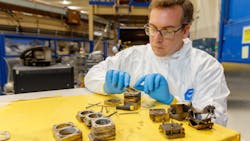Sugar- and Silica-Laminated Coating Protects Equipment
Engineers and scientists at Sandia National Laboratory are developing an even more powerful follow-on version of the lab’s Z Machine, already the most powerful X-ray generator in the world, according to a recent press release from the lab. It will be used to send high-energy X-rays into samples to see how they react.
One aspect of that development project is devising better protection for the test objects, diagnostic equipment and drivers inside the new machine. The protection is needed because when the new X machine fires an X-ray pulse into a sample, much of the energy goes to creating shock waves and knocking debris loose. In fact, according to Sandia researchers, when X-rays are sent into samples, they create forces much like several sticks of dynamite exploding at close range.
“When we try to understand how matter such as metals and polymers interacts with X-rays, we want to know if debris is damaging our samples or changed its microstructure.” says Sandia physicist Chad McCoy. “Right now, we’re at the limit where we can protect sample materials, but more powerful testing machines will require better shielding.”
The Sandia team took a clue from seashells which consist of layers of organic material laminated with layers of inorganic material. The layers work together to reduce and contain shock. For the Sandia material, the organic layer is confectioner’s sugar which has been burnt and transformed into carbon black. The inorganic layer is silica, the most common material on Earth.
The principle of alternating organic and inorganic layers is critical to the strength of the Sandia coating. The carbon-black layers act like a caulk and stop cracks from spreading through the inorganic silica structure. It also provides cushioning layers to increase the coating’s mechanical strength.
The inexpensive, environmentally friendly coating can be layered on a variety of substrates and is light enough to be used on spacecraft as a protective layer because little material is needed to get the same protection as the heavier (but less-effective) shielding currently used.
“Satellites in orbit get hit constantly by debris moving at a few kilometers per second, the same velocity as debris from the Z Machine,” McCoy says. “With this coating, we can make the debris shield thinner, decreasing weight.” If weight is not an issue, thicker coatings of the new material are durable enough to strengthen the walls of pressurized vessels.
According to Guangping, the material used to make a 2-in. circle of the new coating a few microns thick costs 25 cents. In contrast, beryllium wafers, which are being used on the original Z machine and are the closest match to the new coating’s thermal and mechanical properties, cost $700 for a 1-in.-square, 23-micron-thick wafer. That’s 3,800 times the cost of the new material.
Both the new coating and beryllium can survive temperatures well above 1,000°C (2,732°F), but the new coating only uses ethanol along with the carbon black and silica, so it is considered environmentally friendly. Beryllium, on the other hand creates toxic conditions, and its surroundings need to be cleaned after it is used.
Seashell-like coatings initially tested at Sandia varied between a few to 13 layers. Alternating layers of materials were pressed against each other after being heated in pairs, so their surfaces crosslinked. Tests showed that such interwoven nanocomposite layers of silica with carbon black are 80% stronger than silica itself and thermally stable to an estimated 1,650°C. Later sintering efforts showed that layers, self-assembled through a spin-coating process, could be batch-baked and individual surfaces still crosslinked satisfactorily, removing the need to bake each layer.


